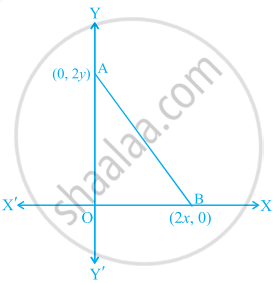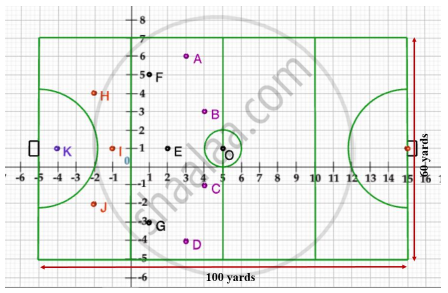Advertisements
Advertisements
प्रश्न
The coordinates of the point which is equidistant from the three vertices of the ΔAOB as shown in the figure is ______.

विकल्प
(x, y)
(y, x)
`(x/2, y/2)`
`(y/2, x/2)`
उत्तर
The coordinates of the point which is equidistant from the three vertices of the ∆AOB as shown in the figure is (x, y).
Explanation:

Let the coordinate of the point which is equidistant from the three vertices 0(0, 0), A(0, 2y) and B(2x, 0) is P(h, k).
Then, PO = PA = PB
⇒ (PO)2 = (PA)2 = (PB)2 ...(i)
By distance formula,
`[sqrt((h - 0)^2 + (k - 0)^2)]^2`
= `[sqrt((h - 0)^2 + (k - 2y)^2)]^2`
= `[sqrt((h - 2x)^2 + (k - 0)^2)]^2`
⇒ h2 + k2 = h2 + (k – 2y)2
= (h – 2x)2 + k2 ...(ii)
Taking first two equations, we get
h2 + k2 = h2 + (k – 2y)2
⇒ k2 = k2 + 4y2 – 4yk
⇒ 4y(y – k) = 0
⇒ y = k ...[∵ y ≠ 0]
Taking first and third equations, we get
h2 + k2 = (h – 2x)2 + k2
⇒ h2 = h2 + 4x2 – 4xh
⇒ 4x(x – h) = 0
⇒ x = h ...[∵ x ≠ 0]
∴ Required points = (h, k) = (x, y)
APPEARS IN
संबंधित प्रश्न
If the point P(x, y) is equidistant from the points A(a + b, b – a) and B(a – b, a + b). Prove that bx = ay.
Name the type of quadrilateral formed, if any, by the following point, and give reasons for your answer:
(−3, 5), (3, 1), (0, 3), (−1, −4)
The long and short hands of a clock are 6 cm and 4 cm long respectively. Find the sum of the distances travelled by their tips in 24 hours. (Use π = 3.14) ?
If the point P(2, 1) lies on the line segment joining points A(4, 2) and B(8, 4), then ______.
Find the distance between the following pair of point in the coordinate plane :
(5 , -2) and (1 , 5)
Prove that the points (1 , 1) , (-1 , -1) and (`- sqrt 3 , sqrt 3`) are the vertices of an equilateral triangle.
Prove that the points (4 , 6) , (- 1 , 5) , (- 2, 0) and (3 , 1) are the vertices of a rhombus.
A point P lies on the x-axis and another point Q lies on the y-axis.
Write the abscissa of point Q.
Find the distance of the following points from origin.
(a+b, a-b)
Case Study -2
A hockey field is the playing surface for the game of hockey. Historically, the game was played on natural turf (grass) but nowadays it is predominantly played on an artificial turf.
It is rectangular in shape - 100 yards by 60 yards. Goals consist of two upright posts placed equidistant from the centre of the backline, joined at the top by a horizontal crossbar. The inner edges of the posts must be 3.66 metres (4 yards) apart, and the lower edge of the crossbar must be 2.14 metres (7 feet) above the ground.
Each team plays with 11 players on the field during the game including the goalie. Positions you might play include -
- Forward: As shown by players A, B, C and D.
- Midfielders: As shown by players E, F and G.
- Fullbacks: As shown by players H, I and J.
- Goalie: As shown by player K.
Using the picture of a hockey field below, answer the questions that follow:

If a player P needs to be at equal distances from A and G, such that A, P and G are in straight line, then position of P will be given by ______.
